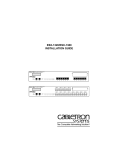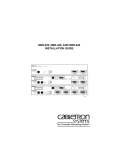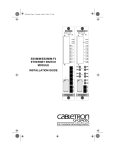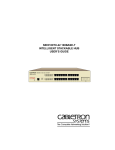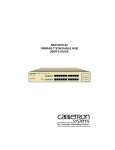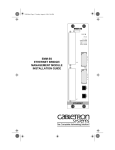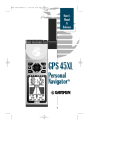Download Cabletron Systems EPIM F3 User`s guide
Transcript
MRXI-22 AND MRXI-24 10BASE-T HUB USER’S GUIDE The Complete Networking Solution™ CABLETRON SYSTEMS, P. O. Box 5005, Rochester, NH 03867-5005 NOTICE Cabletron Systems reserves the right to make changes in specifications and other information contained in this document without prior notice. The reader should in all cases consult Cabletron Systems to determine whether any such changes have been made. The hardware, firmware, or software described in this manual is subject to change without notice. IN NO EVENT SHALL CABLETRON SYSTEMS BE LIABLE FOR ANY INCIDENTAL, INDIRECT, SPECIAL, OR CONSEQUENTIAL DAMAGES WHATSOEVER (INCLUDING BUT NOT LIMITED TO LOST PROFITS) ARISING OUT OF OR RELATED TO THIS MANUAL OR THE INFORMATION CONTAINED IN IT, EVEN IF CABLETRON SYSTEMS HAS BEEN ADVISED OF, KNOWN, OR SHOULD HAVE KNOWN, THE POSSIBILITY OF SUCH DAMAGES. © Copyright May 1993 by: Cabletron Systems Inc. P.O. Box 5005, Rochester, NH 03867-5005 All Rights Reserved Printed in the United States of America Order Number: 9030637-01 May 93 Remote LANVIEW, LANVIEW, and SPECTRUM are registered trademarks of Cabletron Systems, Inc. MRXI and MMAC are trademarks of Cabletron Systems, Inc. IBM is a registered trademark of International Business Machines Corporation. CompuServe is a registered trademark of CompuServe. DEC, VT200, and VT300 are trademarks of Digital Equipment Corporation. Ethernet is a trademark of Xerox Corporation. Hayes is a trademark of Hayes Microcomputer Products Inc. Windows is a registered trademark of Microsoft Corporation i NOTICE FCC NOTICE This device complies with Part 15 of the FCC rules. Operation is subject to the following two conditions: (1) this device may not cause harmful interference, and (2) this device must accept any interference received, including interference that may cause undesired operation. NOTE: This equipment has been tested and found to comply with the limits for a Class A digital device, pursuant to Part 15 of the FCC rules. These limits are designed to provide reasonable protection against harmful interference when the equipment is operated in a commercial environment. This equipment uses, generates, and can radiate radio frequency energy and if not installed in accordance with the operator’s manual, may cause harmful interference to radio communications. Operation of this equipment in a residential area is likely to cause interference in which case the user will be required to correct the interference at his own expense. WARNING: Changes or modifications made to this device which are not expressly approved by the party responsible for compliance could void the user’s authority to operate the equipment. DOC NOTICE This digital apparatus does not exceed the Class A limits for radio noise emissions from digital apparatus set out in the Radio Interference Regulations of the Canadian Department of Communications. Le présent appareil numérique n’émet pas de bruits radioélectriques dépassant les limites applicables aux appareils numériques de la class A prescrites dans le Règlement sur le brouillage radioélectrique édicté par le ministère des Communications du Canada. ii CONTENTS CHAPTER 1 INTRODUCTION 1.1 USING THIS MANUAL ................................................................ 1-1 1.2 GETTING HELP .......................................................................... 1-2 1.3 THE 10BASE-T MRXI ................................................................. 1-2 1.4 LANVIEW LEDs AND LCD DISPLAY.......................................... 1-4 1.5 LOCAL MANAGEMENT .............................................................. 1-4 1.6 NETWORK MANAGEMENT CAPABILITIES .............................. 1-4 1.7 RELATED MANUALS.................................................................. 1-5 CHAPTER 2 2.1 2.2 2.3 2.4 INSTALLATION REQUIREMENTS/SPECIFICATIONS NETWORK REQUIREMENTS .................................................... 2-1 SELECTING A LOCATION FOR THE MRXI............................... 2-1 NETWORK GUIDELINES ........................................................... 2-2 2.3.1 10BASE-T Twisted Pair Network Requirements ............ 2-2 2.3.2 Multi Mode Fiber Optic Network Requirements .............. 2-3 2.3.3 Single Mode Fiber Optic Network Requirements............ 2-4 2.3.4 Thin-Net Network Requirements .................................... 2-5 2.3.5 Transceiver Requirements.............................................. 2-6 2.3.6 AUI Cable Requirements ................................................ 2-6 OPERATING SPECIFICATIONS ................................................ 2-7 CHAPTER 3 INSTALLATION 3.1 UNPACKING THE MRXI ............................................................. 3-1 3.2 ATTACHING THE STRAIN RELIEF BRACKET.......................... 3-1 3.3 INSTALLING THE MRXI ............................................................. 3-2 3.3.1 Rack Mounting the MRXI ................................................ 3-2 3.3.2 Wall Mounting the MRXI ................................................. 3-3 3.3.3 Free-Standing Installation ............................................... 3-5 3.4 CONNECTING THE MRXI TO THE POWER SOURCE ............. 3-6 3.5 CONNECTING THE MRXI TO THE NETWORK......................... 3-6 3.5.1 Connecting the Network Port Cabling............................. 3-7 3.5.2 Connecting a Twisted Pair Segment to an EPIM-T ........ 3-8 3.5.3 Connecting an AUI Cable to an EPIM-X ....................... 3-10 3.5.4 Connecting a Fiber Optic Link Segment to an EPIM-F1, EPIM-F2, or EPIM-F3 ................................... 3-11 3.5.5 Connecting a Thin-Net Segment to an EPIM-C ............ 3-13 3.5.6 Connecting an AUI Cable to an EPIM-A ....................... 3-14 3.6 FINISHING THE INSTALLATION.............................................. 3-15 iii CONTENTS CHAPTER 4 TESTING AND TROUBLESHOOTING 4.1 INSTALLATION CHECK-OUT .....................................................4-1 4.2 TESTING SEGMENTS ATTACHED TO THE MRXI....................4-2 4.3 USING LANVIEW ........................................................................4-5 4.4 THE LCD DISPLAY .....................................................................4-6 CHAPTER 5 LOCAL MANAGEMENT 5.1 TERMINAL CONFIGURATION....................................................5-1 5.1.1 Console Cable Configuration ..........................................5-3 5.1.2 Modem Cable Configuration............................................5-5 5.1.3 Cable Configuration for UPS ...........................................5-5 5.2 ACCESSING LOCAL MANAGEMENT ........................................5-6 5.3 COMMUNITY NAME TABLE .......................................................5-7 5.3.1 Accessing the Community Name Table Screen..............5-8 5.3.2 Community Name Table Screen Fields...........................5-8 5.3.3 Editing the Community Name Table Screen ...................5-9 5.4 CONFIGURING THE MRXI .......................................................5-10 5.4.1 Accessing the Configuration Screen .............................5-10 5.4.2 Configuration Screen Fields ..........................................5-11 5.4.3 Setting the IP Address Table and SubNET Mask Field.5-12 5.4.4 Setting the Default Gateway..........................................5-13 5.4.5 Setting the UPS Option .................................................5-13 5.4.6 Using the Port LOCK Override Option ..........................5-14 5.4.7 Using the Port ENABLE Override..................................5-14 5.5 SETTING THE TRAP TABLE ....................................................5-15 5.5.1 MRXI Trap Table Screen...............................................5-15 5.5.2 Trap Table Screen Fields ..............................................5-16 5.5.3 Configuring the Trap Table............................................5-16 5.6 SNMP TOOLS ...........................................................................5-17 5.6.1 Accessing the SNMP Tools Screen ..............................5-18 5.6.2 SNMP Tools Screen Fields ...........................................5-18 5.6.3 Using SNMP Tools ........................................................5-19 5.7 COMMAND LINE INTERFACE (CLI).........................................5-22 iv CHAPTER 1 INTRODUCTION Welcome to the Cabletron Systems MRXI-22 and MRXI-24 10BASE-T HUB User’s Guide. This manual provides installation instructions and presents reference information for the MRXI-22 and MRXI-24 10BASE-T Hubs. Note: Throughout this manual the term MRXI is used to cover both the MRXI-22 and MRXI-24 unless otherwise specified. 1.1 USING THIS MANUAL Read through this manual completely to familiarize yourself with its content and to gain an understanding of the features and capabilities of the MRXI. A general working knowledge of Ethernet and IEEE 802.3 type data communications networks and their physical layer components will be helpful when installing the MRXI. Chapter 1, Introduction, outlines the contents of this manual, briefly describes features of the MRXI, and concludes with a list of related manuals. Chapter 2, Requirements/Specifications, describes installation requirements, network guidelines, and MRXI operating specifications. Chapter 3, Installation, contains instructions for installing your MRXI and connecting it to the network using the various media types. Chapter 4, Testing and Troubleshooting, contains procedures for testing the MRXI after installation, a description of the LANVIEW ™ LEDs, and explains the use of the front panel LCD display. Chapter 5, Local Management, describes how to access Local Management. It also describes each of the Local Management screens and the available commands. 1-1 INTRODUCTION 1.2 GETTING HELP If you need additional support related to the MRXI-22 or MRXI-24, or if you have any questions, comments, or suggestions concerning this manual, feel free to contact Cabletron Systems Technical Support: By phone ..........................(603) 332-9400 Monday-Friday; 8am - 8pm EST ® .............GO CTRON from any ! prompt By CompuServe By Internet mail [email protected] 1.3 THE 10BASE-T MRXI The MRXI-22 and MRXI-24 are functionally identical. The MRXI-22 provides twelve RJ-45 connectors and the MRXI-24 provides twenty-four RJ-45 connectors for network ports. Additional network connections are made through the use of front panel EPIM modules (one module for the MRXI-22, two modules for the MRXI-24). A variety of EPIMs are available permitting the expansion of an Ethernet/802.3 network via: • Unshielded Twisted Pair Cable from the 10BASE-T Twisted Pair Interface Module (EPIM-T). • Fiber Optic Cable, with SMA or ST connectors, from the Fiber Optic Interface Modules (EPIM-F1, EPIM-F2 or EPIM-F3). • Thin-Net Cable from the Coaxial Interface Module (EPIM-C). • AUI Cable from the AUI Interface Module (EPIM-A or EPIM-X). MRXI-24 10BASE-T HUB with LANVIEW The Complete Networking Solution Figure 1-1 1-2 The MRXI-24 INTRODUCTION The MRXI fully conforms to the IEEE 802.3 Repeater, AUI, and 10BASE-T specifications, and provides the flexibility to connect networks using IEEE 802.3, Ethernet Version 1 or Version 2 equipment. A Repeater Interface Controller (RIC) in the MRXI provides full 802.3 repeater capabilities integrated into a single chip. The MRXI transmits re-timed data packets, regenerates the preamble, extends fragments, and arbitrates collisions. The MRXI automatically partitions problem segments, and reconnects non-problem segments to the network. This feature minimizes the impact on network operation resulting from a problem on one segment by isolating the problem segment. Only devices on the problem segment are affected. When the problem is solved, the MRXI automatically reconnects the isolated segment to the network. Since the MRXI utilizes polarity detection and correction, the twisted pair connections are not sensitive to signal polarity. The network will still function properly with the (+) and (–) lines within a pair reversed. Operating in this condition is not recommended and if this condition is discovered, the segment should be removed from the network and wired correctly by a technician. This reduces the potential for problems in the future if equipment changes are made. Connector pinouts are provided in Chapter 2, Installation Requirements / Specifications. You can configure the two front panel serial ports to support an SNMP proxy for Uninterruptible Power Supplies (UPS) or the Serial Line Internet Protocol (SLIP). MIB II and RMON support are built into the MRXI for network analyzer functionality. In addition, Cabletron’s Distributed LAN Monitor (DLM), a software option for the MRXI, provides a method for locally polling and monitoring devices on a LAN to minimize network management traffic on an enterprise, campus, or wide area network. The MRXI uses Flash EEPROMs that allow you to download new and updated firmware using Cabletron Systems Remote LANVIEW/Windows, version 2.3 or later or any device using BOOTP or TFTP protocols. The front panel of the MRXI also has a reset switch to initialize the processor. 1-3 INTRODUCTION 1.4 LANVIEW LEDS AND LCD DISPLAY Cabletron Systems’ LANVIEW Status Monitoring and Diagnostics System is a convenient troubleshooting tool that helps you diagnose power failures, collisions, cable faults, and link problems. The front panel LCD display provides information about the MRXI such as power up diagnostics, revision levels, MAC and IP addresses, and error alerts. 1.5 LOCAL MANAGEMENT There are two RJ-45 ports on the front panel of the MRXI that let you access Local Management by connecting a DEC VT™ 320 terminal or a PC using VT320 emulation software. Refer to Chapter 5, Local Management. 1.6 NETWORK MANAGEMENT CAPABILITIES The MRXI can be controlled and managed by any SNMP network management system. These include: • • • • Cabletron Systems SPECTRUM® Cabletron Systems Remote LANVIEW®/Windows™ Cabletron Systems Remote LANVIEW® for SunNet™ Manager Third Party SNMP compliant Network Management Packages The MRXI network management capabilities provide the necessary management tools for the MRXI to operate at its full capacity. Your ability to set up parameters with network management ensures optimal performance of the MRXI. For example, you can gather a large amount of statistical information about the MRXI, including the number of: • • • • • 1-4 Packets Transmit Collisions Runt Packets CRC Errors Bytes Received • • • • Receive Collisions Giant Packets Misaligned Packets Out of Window Collisions INTRODUCTION For specific information, refer to the applicable network management package user’s manual. 1.7 RELATED MANUALS Use the following manual to supplement the procedures and other technical data provided in this manual. The procedures contained in the following manual are referenced where appropriate, but not repeated in this manual. Cabletron Systems LAN-MD Portable Ethernet Tester User's Manual. 1-5 INTRODUCTION 1-6 CHAPTER 2 INSTALLATION REQUIREMENTS/SPECIFICATIONS This chapter describes network guidelines, power requirements, and operating specifications for the MRXI. Be sure that you read this chapter before you install the MRXI. Your network must meet the requirements and conditions specified in this chapter to obtain satisfactory performance from this equipment. Failure to follow these guidelines could result in poor network performance. 2.1 NETWORK REQUIREMENTS When connecting a network segment to the MRXI, via a transceiver and an AUI cable, the following network requirements must be met: • The transceivers used to connect the MRXI meet Ethernet Version 2 or IEEE 802.3 standards. • The AUI cables connecting the MRXI to the transceivers on the network match the transceiver type on the network segment, Ethernet Version 1, Version 2, or IEEE 802.3 type cables, and do not exceed 50 meters in length. 2.2 SELECTING A LOCATION FOR THE MRXI You can mount the MRXI on a wall, a 19-inch rack, or place it on any horizontal surface. If you choose not to install the MRXI in a 19-inch rack, the location must be within reach of the network cabling and meet the requirements listed below: • An unrestricted free surface area at least 21 inches wide, 18 inches deep, and 6 inches high is needed. • A single phase 120 Vac, 15A, grounded power receptacle must be located within 7 feet of the location. • If you use a shelving unit, it must be able to support 30 pounds of static weight. • The temperature for the selected location must be maintained between 5° and 50°C, and fluxuate less than 10°C per hour. 2-1 INSTALLATION REQUIREMENTS/SPECIFICATIONS 2.3 NETWORK GUIDELINES Take care in planning and preparing the connections and the cables for your network. The quality of the connections, the length of the cables, and the location of the MRXI are critical factors in determining the reliability of your network. The following sections describe the network guidelines to operate this equipment. 2.3.1 10BASE-T Twisted Pair Network Requirements The device at the other end of the twisted pair segment must meet IEEE 802.3 10BASE-T specifications. When you connect a 10BASE-T Twisted Pair Segment to the MRXI’s 10BASE-T Twisted Pair Ports, the following network requirements must be met: • Length - The IEEE 802.3 10BASE-T standard requires that 10BASE-T devices transmit over a 100 meter (328 foot) link using 22-24 AWG unshielded twisted pair wire. As a general rule, links up to 130 meters in length for unshielded twisted pair and 200 meters in length for shielded twisted pair are achievable. For each connector or patch panel in the link, subtract 12 meters from the 150 meter limit. This allows for links of up to 126 meters using standard 24 AWG UTP wire and two patch panels within the link. Higher quality low attenuation cables may be required when using links of greater than 126 meters. Due to cable delay, the maximum link length is always limited to 200 meters, regardless of the cable type. • Insertion Loss - The maximum insertion loss allowed for a 10BASE-T link is 11.5 dB at all frequencies between 5.0 and 10 MHz. This includes the attenuation of the cables, connectors, patch panels, and reflection losses due to impedance mismatches in the link segment. • Impedance - Unshielded twisted pair cables typically have an impedance of between 85 to 110 ohms. Shielded twisted pair cables, such as IBM Type 1 cable, can also be used. You should remember that the impedance of IBM Type 1 cable is typically 150 ohms. This increases the signal reflection caused by the cable, but since the cable is shielded, this signal reflection has little effect on the received signal’s quality due to the lack of crosstalk between the shielded cable pairs. Cabletron Systems 10BASE-T Twisted Pair products will work on twisted pair cable with 75 to 165 ohms impedance. 2-2 INSTALLATION REQUIREMENTS/SPECIFICATIONS • Jitter - Intersymbol interference and reflections can cause jitter in the bit cell timing, resulting in data errors. A 10BASE-T link must not generate more than 5.0 nsec. of jitter. If your cable meets the impedance requirements for a 10BASE-T link, jitter should not be a concern. • Delay - The maximum propagation delay of a 10BASE-T link segment must not exceed 1000 nsec. This 1000 nsec. maximum delay limits the maximum link segment length to no greater than 200 meters. • Crosstalk - Crosstalk is caused by signal coupling between the different cable pairs contained within a multi-pair cable bundle. 10BASE-T transceivers are designed so that the user does not need to be concerned about cable crosstalk, provided the cable meets all other requirements. • Noise - Noise can be caused by either crosstalk or externally induced impulses. Impulse noise may cause data errors if the impulses occur at very specific times during data transmission. Generally, the user need not be concerned about noise. If noise-related data errors are suspected, it may be necessary to either reroute the cable or eliminate the source of the impulse noise. • Temperature - Multi-pair PVC 24 AWG telephone cables typically have an attenuation of approximately 8 to 10 dB/100m at 20° C (78° F). The attenuation of PVC insulated cable varies significantly with temperature. At temperatures greater than 40° C (104° F), it is strongly recommended that you use plenum-rated cables to ensure that cable attenuation remains within specification. 2.3.2 Multi Mode Fiber Optic Network Requirements When you connect a Fiber Optic Link Segment to the MRXI with a Single Port Fiber Optic Interface Module (EPIM-F1 or EPIM-F2), the following network requirements must be met: • Cable Type - The EPIM-F1 and EPIM-F2 are designed for use with one of the following multimode fiber optic media: - 50/125 µm fiber optic cabling. 62.5/125 µm fiber optic cabling. 100/140 µm fiber optic cabling. 2-3 INSTALLATION REQUIREMENTS/SPECIFICATIONS • Attenuation - The fiber optic cable must be tested with a fiber optic attenuation test set that is adjusted for an 850 nm wavelength. This test verifies that the signal loss in a cable is within an acceptable level: - 13.0 dB or less for 50/125 fiber cable segment. 16.0 dB or less for 62.5/125 fiber cable segment. 19.0 dB or less for 100/140 fiber cable segment. • Budget and Propagation Delay - When determining the maximum fiber optic cable length, the fiber optic budget delay and total network propagation should be calculated and taken into consideration before fiber optic cable runs are incorporated in any network design. Fiber optic budget is the combination of the optical loss due to the fiber optic cable, in-line splices, and fiber optic connectors. Propagation delay is the amount of time it takes a packet to travel from the sending device to the receiving device. • Length - The maximum allowable fiber optic cable length is 2 km. However, IEEE 802.3 specifications allow for a maximum of 1 km. 2.3.3 Single Mode Fiber Optic Network Requirements When you connect a Single Mode Fiber Optic Link Segment to the MRXI with a Fiber Optic Ethernet Port Interface Module (EPIM-F3), the following network requirements must be met: • The fiber optic link segment should consist of 8/125 - 12/125 µm single mode µm fiber optic cabling. You can also use 62.5/125 µm multi mode cable, however optical loss will be greater with multi mode cable and distances will be limited to 2 km. • The fiber optic cable must be tested with a fiber optic attenuation test set that is adjusted for a 1300 nm wave length. This test verifies that the signal loss in a cable is within an acceptable level of 10.0 dB or less for any given single mode fiber optic link. • When determining the maximum fiber optic cable length, the fiber optic budget (total loss of 10.0 dB or less between stations) and total network propagation delay should be calculated and considered before fiber runs are incorporated in any network design. 2-4 INSTALLATION REQUIREMENTS/SPECIFICATIONS • Fiber optic budget is the combination of the optical loss due to the fiber optic cable, in-line splices, and fiber optic connectors (the loss for each splice and connector is typically 1 dB or less). • Propagation delay is the amount of time it takes a packet to travel from the sending device to the receiving device. Total propagation delay allowed for the entire network is 25.6 µsec. If the total propagation delay between any two nodes on the network exceeds 25.6 µsec, then bridges should be used. • When using single mode fiber optic cable, segment lengths up to 10 km are possible if system budgets are met. However, IEEE 802.3 FOIRL specifications allow for a maximum length of 1 km. 2.3.4 Thin-Net Network Requirements When you connect a Thin-net segment to the MRXI with a Coax Interface Module (EPIM-C), the following network requirements must be met: • Cable Type - 50 ohm RG-58A/U type coaxial cable must be used when making up a thin-net cable segment. • Length - The thin-net segment must be no longer than 185 meters. • Terminations - A 50 ohm terminator must be connected to the far end of each thin-net segment. • Connections - A maximum of 29 tee-connectors may be used throughout the length of cable segment for host connections. If an excessive number of barrel connectors are used within the cable segment, such as finished wall plates with BNC feed-throughs, then a reduced number of host connections may be required. For special network design, contact Cabletron Systems Technical Support. • Grounding - For safety, only one end of a thin-net segment should be connected to earth ground. Connection to earth ground at more than one point on the segment could produce dangerous ground currents. The BNC ports of the Coaxial Interface Modules are not connected to earth ground. Warning: Do not connect the shield at both ends of a thin net segment to ground. Only one end of the shield should be connected to earth ground. Multiple ground paths can introduce noise or a hazardous voltage potential onto the cable. 2-5 INSTALLATION REQUIREMENTS/SPECIFICATIONS 2.3.5 Transceiver Requirements When you connect an external network segment, via a transceiver, to the MRXI with an EPIM-A, the following requirements must be met: • The transceiver or Ethernet Device to which the module will be connected must meet IEEE 802.3 standards, and/or Ethernet Version 1.0 or Version 2.0 standards. • The Signal Quality Error (SQE) test function on the transceiver must be disabled if you connect it to a repeater or to an Ethernet Version 1.0 device. In addition, some Version 2.0 equipment does not support the SQE test. Devices that do not support SQE test interpret the SQE test pulse as a collision. 2.3.6 AUI Cable Requirements When you connect an external network segment to the MRXI with an EPIM-A or EPIM-X, the AUI cable must meet the following requirements: • AUI Cable - The AUI cable connecting the module to a device must be IEEE 802.3 type cable. • Length - The AUI Cable must not exceed 50 meters in length. If 28 AWG thin office drop AUI cable is used, then the maximum cable length is limited to 50 feet (15.24 meters). • Grounding - The connector shell of the EPIM-A and the EPIM-X are connected to ground. 2-6 INSTALLATION REQUIREMENTS/SPECIFICATIONS 2.4 OPERATING SPECIFICATIONS The operating specifications for the MRXI are described in this section. Cabletron Systems reserves the right to change these specifications at any time without notice. GENERAL Operating System Memory: 4 MB Internal Processor: Intel 80C960CA operating at 24 MHz Ethernet Controller: National Semiconductor DP83932 Static RAM: 128 KB with battery back-up EPROM: 128 KB FLASH MEMORY: 2 MB Delay Times (Start of Packets): Twisted Pair to EPIM- A 900 nsec. Twisted Pair to Twisted Pair 1 msec. EPIM-A to Twisted Pair 750 nsec. Delay Times (JAM): Twisted Pair to EPIM-A 1.16 msec. Preamble: Input: Minimum of 40 bits required. Output: 64 bits min. (last 2 bits are 1, 1). 2-7 INSTALLATION REQUIREMENTS/SPECIFICATIONS JAM Output: Collisions are propagated through the network using the JAM signal of an alternating pattern of 1's and 0's in accordance with 802.3 specifications for a repeater unit. Fragment Extension: Packet fragments are extended to a minimum of 96 bits using the JAM [1,0]. Fault Protection: Each segment will disconnect itself from the other segments if 31 consecutive collisions occur, or if the collision detector of a segment is on for longer than approximately 110 µs. This fault protection will reset automatically after one packet is transmitted/received onto the fault protected segment without causing a collision. INTERFACE CONNECTORS Network (Twisted Pair) Interface Type: Internally Crossed Over RJ-45 Connector Pin-out for RJ-45 Connector Pin 1 2 3 4 2-8 RX+ RXTX+ No Connection 5 6 7 8 No Connection TXNo Connection No Connection INSTALLATION REQUIREMENTS/SPECIFICATIONS Ethernet Port - EPIM-T (10BASE-T Twisted pair Port) Internal Transceiver: Cabletron Systems TPT-T™ 10BASE-T Twisted Pair Transceiver Type: Pin RJ-45 Connector The slide switch on the EPIM-T determines if the cable pairs are internally swapped in the module. If the switch is on the X side, the pairs are swapped. If the switch is on the II side, the pairs are not internally swapped. Pin-outs for RJ-45 connector Position II (not crossed over) Position X (crossed over) 1 2 3 4 TX+ TXRX+ NC 5 6 7 8 NC RXNC NC 1 2 3 4 RX+ RXTX+ NC 5 6 7 8 NC TXNC NC Ethernet Port - EPIM-F1 or EPIM-F2 (Fiber Optic Port) Internal Transceiver: Cabletron Systems FOT-F™ Fiber Optic Transceiver Type: EPIM-F1 (SMA fiber optic ports) EPIM-F2 (ST fiber optic ports) Parameter Typical Value Worst Case Worst Case Typical Budget Budget Receive Sensitivity: -30.5 dBm -28.0 dBm — — Peak Input Power: -7.6 dBm — — -8.2 dBm 2-9 INSTALLATION REQUIREMENTS/SPECIFICATIONS Parameter Typical Value Worst Case Worst Case Typical Budget Budget Transmitter Power 50/125 µm fiber: -13.0 dBm -15.0 dBm 13.0 dB 17.5 dB 62.5/125 µm fiber: -10.0 dBm -12.0 dBm 16.0 dB 20.5 dB 100/140 µm fiber: -7.0 dBm -9.0 dBm 23.5 dB Error Rate: 19.0 dB Better than 10-10 Note: The transmitter power levels and receive sensitivity levels listed above are Peak Power Levels after optical overshoot. A Peak Power Meter must be used to correctly compare the values given above to those measured on any particular port. If Power Levels are being measured with an Average Power Meter, then 3 dBm must be added to the measurement to correctly compare those measured values to the values listed above (i.e. -30.5 dBm peak=-33.5 dBm average). Ethernet Port - EPIM-F3 Internal Transceiver: Cabletron Systems FOT-F3™ Fiber Optic Transceiver Type: ST fiber optic ports. Note: Transmitter Power decreases as temperatures rise and increases as temperatures fall. Use the Output Power Coefficient to calculate increased or decreased power output for your operating environment. For example, the typical power output at 25° C is -16.4 dBm. For a 4° C temperature increase, multiply the typical coefficient (-0.15 dBm) by four and add the result to typical output power (4 x -0.15 dBm + -16.4 = -17.0). 2-10 INSTALLATION REQUIREMENTS/SPECIFICATIONS Maximum Sensitivity (-36.0) Receive Sensitivity Typical Sensitivity (-31.0) Minimum Sensitivity (-30.0) Minimum Receive Input (-9.72) Typical Receive Input (-7.5) Maximum Receive Input Power Maximum Receive Input (-6.99) Maximum Transmit Power (-12.0) Transmitter Power* (At 25°C into 8.3/125µm fiber) Typical Transmit Power (-15.5) Minimum Transmit Power (-21.0) dBm -40 -35 -30 -25 -20 -15 Less Power -10 -5 0 More Power * Transmit Power Typical Power Coefficient (See Note Below)-0.15dBm/ Minimum Power °C -0.12 dBm/ Maximum Power °C-0.18 dBm/ Parameter Typical Minimum Maximum Transmitter Peak Wave Length 1300 nm 1270 nm Spectral Width 60 nm Rise Time/ Fall Time °C 1330 nm - 100 nm 3.0 nsec 2.5 nsec 2.7 nsec 2.2 nsec 5.0 nsec 5.0 nsec Duty Cycle 50.1% 49.6% 50.7% Bit Error Rate: Better than 10-10 Note: The transmitter power levels given above are Peak Power Levels after optical overshoot. You must use a Peak Power Meter to correctly compare the values given above to those measured on any particular port. If you are measuring power levels with an Average Power Meter, add 3 dBm to the average power measurement to correctly compare the average power values measured to the values listed above (i.e. -33.5 dBm average + 3 dB = -30.5 dBm peak). 2-11 INSTALLATION REQUIREMENTS/SPECIFICATIONS Ethernet Port - EPIM-C (BNC Port) Internal Transceiver: Cabletron Systems TMS-3™ Transceiver. Termination: The port on the module can be internally terminated, to an internal 50 Ohm terminator, utilizing the switch located to the left of the port. This eliminates the need to connect the port to a Tee Connector and terminator. Type: BNC receptacle, with gold center contact, for use with BNC type tee-connectors and RG-58 thin-net cable. Grounding: For safety, only one end of a thin-net segment should be connected to earth ground. Connection to earth ground at more than one point on the segment may cause dangerous ground currents. The BNC port of the Coaxial Interface Modules is not connected to earth ground. Ethernet Port - EPIM-A and EPIM-X (AUI Port) Interface Connector: DB-15 Port (male connector for EPIM-A, female connector for EPIM-X) Type: 15 position D type receptacle Pin 1 2 3 4 5 6 7 Logic Ref. Collision + Transmit Logic Ref. Receive + Power Return No Connection Connector Shell: 2-12 9 10 11 12 13 14 15 Collision Transmit Logic Ref. Receive Power (+12Vdc) Logic Ref. No Connection Protective Ground INSTALLATION REQUIREMENTS/SPECIFICATIONS Console Port The RJ-45 Console port supports access to a Local Management Console. The Console port supports a Digital Equipment Corporation, VT 320™ terminal or PC emulation of the VT 320™ terminal. Type: Pin 1 2 3 4 8 pin RJ-45 Port Not Used 5 Data Terminal Ready (DTR)6 Transmit Data (TX) 7 Not Used 8 Signal Ground (SG) Receive Data (RX) Data Set Ready (DSR) Not Used Modem Port The RJ-45 Modem Port supports access to Local Management via a Hayes compatible modem. You can also use this port to support an Uninterruptible Power Supply (UPS). Type: 8 pin RJ-45 Port Pin 1 2 3 4 Transmit Data Data Carrier Detect (DCD) Not Used Receive Data (RX) 5 6 7 8 Signal Ground (SG) Data Terminal Read(DTR) Not Used Ring Detect LANVIEW INDICATORS PWR (green): Indicates that the repeater is receiving power. LNK (green): Indicates that a link has been established between the module and the 10BASE-T device at the other end of the twisted pair segment. This LED remains lit as long as the link is maintained. 2-13 INSTALLATION REQUIREMENTS/SPECIFICATIONS RCV (yellow): Indicates that the repeater is receiving a data packet on that segment. CPU (flashing green): This LED alternates from red to green during power up. After the boot is complete, the LED flashes green. A flashing green LED indicates normal operation. A red LED indicates a fault in the processor. POWER SUPPLY REQUIREMENTS Note: The MRXI has a universal power supply. This unit allows you to use an input power from 85 to 264 VAC, 47-63 Hz. Parameter Typical Value Worst Case Input Current: 0.5 A 0.75 A Overload Protection - Output: (1) 2AG 1 amp fuse. ENVIRONMENTAL REQUIREMENTS Operating Temperature: +5° to +50° C Non-operating Temperature: -30° to +90° C Operating Humidity: 5 to 95% (non-condensing) SAFETY Designed in accordance with UL478, UL910, NEC 725-2(b), CSA, IEC, TUV, VDE class A. Meets FCC part 15, Class A limits. Warning: It is the responsibility of the person who sells the system to which the MRXI will be a part to ensure that the total system meets allowed limits of conducted and radiated emissions. 2-14 INSTALLATION REQUIREMENTS/SPECIFICATIONS SERVICE MTBF (MHBK-217D): >70,040 hrs. projected MTTR: < 0.5 hr. PHYSICAL Dimensions: 2.8H x 17.0W x 13.5D inches (7.2 x 43.6 x 34.6 cm) Weight: 7 lbs. 2-15 INSTALLATION REQUIREMENTS/SPECIFICATIONS 2-16 CHAPTER 3 INSTALLATION This chapter outlines the procedure for installing your MRXI and connecting it to a network. Ensure that your network meets the guidelines and requirements outlined in Chapter 2, Installation Requirements/Specifications, before installing the MRXI. 3.1 UNPACKING THE MRXI Unpack the MRXI as follows: • Remove the two plastic bags containing the accessories. • Remove the MRXI from the shipping box. • Slide the two foam end caps off the MRXI. • Remove the MRXI from the protective plastic bag and set it aside to prevent damage. Before you install the MRXI visually inspect the unit and check the contents of the accessory package. Contact Cabletron Systems Technical Support immediately if you find any discrepancies. 3.2 ATTACHING THE STRAIN RELIEF BRACKET Attach the strain relief bracket to the front of the MRXI as follows: 1. Locate the strain relief bracket and four 8-32 x 3/8” screws from the MRXI installation kit. Warning: Use of longer screws may cause damage to the unit or electrical shock. 2. Attach the strain relief bracket to the bottom of the MRXI as shown in Figure 3-1. 3-1 INSTALLATION MRXI 10 BASE-T HUB with LANVIEW Figure 3-1 3.3 Attaching the Strain Relief INSTALLING THE MRXI You can mount the MRXI on a wall, a 19-inch rack, or place it free-standing on any horizontal surface (i.e., shelf or desk, etc.). Select one of the following subsections and perform the steps that are applicable for your installation. 3.3.1 Rack Mounting the MRXI Refer to Figure 3-2 and perform these steps to install the MRXI in a 19-inch rack. 1. Remove four cover screws (two from each side) located along the front edges of each side of the MRXI. 2. Using the four cover screws removed in step 1, attach the rack mounting brackets to each end of the MRXI. 3-2 INSTALLATION Rackmount Brackets (2) MRXI 10 BASE-T HUB with LANVIEW Screws (4) Figure 3-2 Rack Mount Brackets Installation 3. With the mounting brackets installed, position the MRXI between the vertical frame members of the 19-inch rack and fasten it securely with the mounting screws as shown in Figure 3-3. 19-Inch Rack MRXI 10 BASE-T HUB with LANVIEW Screws (4) Figure 3-3 3.3.2 Installing the MRXI in the Rack Wall Mounting the MRXI When you wall mount the MRXI, the cable connections must face down. Refer to Figure 3-4 and perform the following steps to wall mount the MRXI. 3-3 INSTALLATION Note: 1/4-inch Molly screw anchors for wall mounting are not included with the MRXI. 1. Use the supplied screws to attach the wall mounting brackets to the bottom of the MRXI as shown in Figure 3-4. There are two brackets, one for each side. Figure 3-4 Installing the Wall Mounting Brackets 2. Select the wall location for the MRXI within 7 feet of a power outlet. WARNING: There is a potential SHOCK HAZARD if there is electrical wiring within the wall that interferes with drilling for pilot holes. Select a wall location where drilling pilot holes for the Molly screws will not come in contact with electrical wiring in the wall. 3. You will need a pencil for this step. With the wall mounting brackets attached to the MRXI, position the MRXI against the wall where it will be permanently mounted with the network port facing down. Use the pencil to mark the wall location for the four pilot holes. 4. Set the MRXI aside and carefully drill four 1/4” pilot holes, one for each of the Molly screw anchors and insert the four Molly screw anchors into the holes just drilled. 3-4 INSTALLATION Molly Anchor Figure 3-5 Wall Mounting the MRXI 5. Tighten each of the anchor screws until the anchor expands holding the anchor firmly in the wall, then remove the screws completely. 6. Position the MRXI on the wall over the anchors and reinstall the four anchor screws to attach the MRXI to the wall, as shown in Figure 3-5. Tighten the four anchor screws. 3.3.3 Free-Standing Installation For a free-standing shelf or tabletop installation, locate the MRXI within 7 feet of its power source and with an unrestricted free surface area 21 inches wide, 18 inches deep, and 6 inches high, as shown in Figure 3-6. 3-5 INSTALLATION C B MRXI 10 BASE-T HUB with LANVIEW A A = 15 cm (6 in) B = 46 cm (18 in) C = 53 cm (21 in) D = 213 cm (7 ft) Figure 3-6 3.4 D Shelf or Table-top Installation CONNECTING THE MRXI TO THE POWER SOURCE Note: The MRXI has a universal power supply. This allows you to connect the MRXI to power sources from 85 Vac to 264 Vac, 47-63 Hz. To connect the MRXI to the power source, plug the power cord into a grounded wall outlet. Turn on the power switch at the back panel of the MRXI. Verify that the PWR LED is lit, this indicates that the MRXI is receiving power. After the MRXI runs a self test, the CPU LED flashes green indicating normal operation. If the LED remains red, the processor is faulty. 3.5 CONNECTING THE MRXI TO THE NETWORK The procedure for connecting Ethernet segments to the MRXI varies depending on the media and ports being connected. Refer to the following list and perform the procedure described in the subsections that apply to your MRXI: • • • • • • 3-6 Network Port (MRXI-22/24), refer to subsection3.5.1 EPIM-T, refer to subsection 3.5.2 EPIM-X, refer to subsection 3.5.3 EPIM-F1, F2, F3, refer to subsection 3.5.4 EPIM-C, refer to subsection 3.5.5 EPIM-A, refer to subsection3.5.6 INSTALLATION 3.5.1 Connecting the Network Port Cabling You attach unshielded twisted pair segments to the RJ-45 Network Ports on the front panel of the MRXI. Since the MRXI utilizes polarity detection and correction, the twisted pair connections are not sensitive to signal polarity. The network will still function properly with the (+) and (–) lines within a pair reversed. Operating in this condition is not recommended and if this condition is discovered, the segment should be removed from the network and wired correctly by a technician. 1. Connect twisted pair segments to the MRXI Network Port (see Figure 3-7) by inserting the RJ-45 connector from each twisted pair segment into the desired RJ-45 port number on the MRXI. EPIM 1 24X 23X 12X 22X 21X 20X 19X 11X 10X 9X Figure 3-7 8X 7X 18X 17X 16X 15X 14X 13X 6X 5X 3X 4X 2X 1X EPIM 1 MRXI-24 Network Ports 2. Check that the associated LNK LED for the port is lit. If the LED is not lit, perform each of the following steps until it is: a. Check that the 10BASE-T device at the other end of the twisted pair segment is powered up. b. Verify that the RJ-45 connector on the twisted pair segment has the proper pin-outs as shown in Figure 3-8. 3-7 INSTALLATION NETWORK Port (1-12) NOTE: RX+/RX– and TX+/TX– must share a common color pair. Figure 3-8 10BASE-T DevicePort RX+ 1 1 TX+ RX– 2 2 TX– RJ-45 to RJ-45 TX+ 3 3 RX+ TX– 6 6 RX– Cable Pin-outs - RJ-45 Network Ports c. Check the cable for continuity. d. Check that the twisted pair connection meets dB loss and cable specifications outlined in 10BASE-T Twisted Pair Network Requirements. e. Check that the cross-over switch is in the correct position. If a link still has not been established, contact Cabletron Systems Technical Support. 3.5.2 Connecting a Twisted Pair Segment to an EPIM-T Before connecting a segment to the EPIM-T, check each end of the segment to determine if the wires have been crossed-over for the proper connection (see Figure 3-11 for proper pin-outs). If the wires are not crossed-over you can use the switch on the EPIM-T (Figure 3-9) to internally cross-over the RJ-45 port, eliminating the need to rewire the twisted pair segment going into the port. If the wire is crossed-over, set the switch on the EPIM to the = position. If not crossed-over, set the switch to the X position. 3-8 INSTALLATION Switch Figure 3-9 II X EPIM-T Front Panel EPIM-T Cross-over Switch To connect a EPIM-T to a Twisted Pair Segment: 1. Connect the twisted pair segment to the module by inserting the RJ-45 connector on the twisted pair segment into the RJ-45 port on the module. See Figure 3-10. LNK EPIM-T Figure 3-10 The EPIM-T 2. Check that the LNK LED for the port is lit. If the LED is not lit, perform each of the following steps until it is: a. Check that the 10BASE-T device at the other end of the twisted pair segment is powered up. b. Verify that the RJ-45 connector on the twisted pair segment has the proper pin-outs as shown in Figure 3-11. c. Check the cable for continuity. 3-9 INSTALLATION d. Check that the twisted pair connection meets dB loss and cable specifications outlined in 10BASE-T Twisted Pair Network Requirements. e. Check that the cross-over switch is in the correct position. 10BASE-T Device Port EPIM-T Port NOTE: RX+/RX- and TX+/TX- RX+ 1 RX- 2 Figure 3-11 TX+ 2 TX- RJ-45 to RJ-45 must share a common color pair. 1 TX+ 3 3 RX+ TX- 6 6 RX- Cable Pin-outs - EPIM-T RJ-45 Port If a link still has not been established, contact Cabletron Systems Technical Support. 3.5.3 Connecting an AUI Cable to an EPIM-X To connect an EPIM-X to an external network device, attach an AUI cable, no longer than 50 meters in length, to the port located on the EPIM-X. See Figure 3-12. You must also set the SQE switch to off. CAUTION: Ensure that the external transceiver to which the MRXI will be connected does not have the signal quality error (SQE or “heartbeat”) test function enabled. The MRXI will not operate if the transceiver has the SQE test function enabled, and the network will be unusable. Refer to the applicable transceiver manual. 3-10 INSTALLATION SQE EPIM-X Figure 3-12 3.5.4 The EPIM-X Connecting a Fiber Optic Link Segment to an EPIM-F1, EPIM-F2, or EPIM-F3 When connecting a fiber optic link segment to an EPIM-F1, F2, or F3 keep the following in mind: • If you are connecting a fiber optic link segment with SMA 906 connectors to an EPIM-F1 with SMA ports, ensure that half alignment sleeves are in place on each connector. A full alignment sleeve will damage the receive port. SMA 905 connectors do not need alignment sleeves. • If you are connecting a fiber optic link segment with ST connectors to an EPIM-F2 with ST ports, keep in mind that ST connectors attach to ST ports much like BNC connectors attach to BNC ports. The connector is inserted into the port with the alignment key on the connector inserted into the alignment slot on the port. The connector is then turned to lock it down. • The physical communication link consists of two strands of fiber optic cabling: the Transmit (TX) and the Receive (RX). The Transmit strand from the applicable port on the module will be connected to the Receive port of a fiber optic Ethernet device at the other end of the segment. For example, TX of the applicable port on the module will go to RX of the other fiber optic device. The Receive strand of the applicable port on the module will be connected to the Transmit port of the fiber optic Ethernet device. For example, RX of the applicable port on the module will go to TX of the other fiber optic device. We recommend that you label the fiber optic cable to indicate which fiber is Receive and which is Transmit. When you buy fiber optic 3-11 INSTALLATION cable from Cabletron Systems, it is labeled so that: at one end of the cable, one fiber is labeled 1, and the other fiber is labeled 2. This pattern is repeated at the other end of the cable. If you did not purchase your cable from Cabletron Systems, be sure you have labeled your cable in the manner described above. CAUTION: Do not touch the ends of the fiber optic strands, and do not let the ends come in contact with dust, dirt, or other contaminants. Contamination of the ends can cause problems in data transmissions. If the ends become contaminated, clean them with alcohol using a soft, clean, lint free cloth. To connect a fiber optic link segment to an EPIM-F1 or an EPIM-F2: 1. Remove the protective plastic covers from the fiber optic ports on the applicable port on the module and from the ends of the connectors on each fiber strand. 2. Attach the fiber labeled 1 to the applicable receive port, labeled RX, on the module. See Figure 3-13. RX TX RX LNK EPIM-F1/F2 Figure 3-13 TX LNK EPIM-F3 The EPIM-F1/F2 and EPIM-F3 3. Attach the fiber labeled 2 to the applicable transmit port labeled TX, on the module. 4. At the other end of the fiber optic cable, attach the fiber labeled 1 to the transmit port of the device. 5. Attach the fiber labeled 2 to the receive port. 6. Check that the LNK LED on the applicable port on the module is lit. If the LED is not lit, perform each of the following steps until it is: a. Check that the power is turned on for the device at the other end of the link. b. Verify that the fiber strands are properly “crossed over” between the applicable port on the module and the fiber optic device at the other end of the fiber optic link segment. 3-12 INSTALLATION c. Verify that the fiber connection meets the dB loss specifications outlined in Fiber Optic Network Requirements. If a link still has not been established, contact Cabletron Systems Technical Support. 3.5.5 Connecting a Thin-Net Segment to an EPIM-C To connect a thin-net segment to an EPIM-C: 1. Set the Internal Termination Switch (see Figure 3-14), located to the right of the port and labeled TERM to: • The on position (•) if the thin-net segment connected directly to the port will be internally terminated at the port. • The off position (o) if the thin-net segment will not be terminated at the port or externally terminated. 2. If the Internal Termination switch is in the On position, connect the thin-net segment directly to the BNC port. 3. If the Internal Termination switch is in the Off position: a. Attach a BNC tee-connector to the BNC port on the module. b. Attach the thin-net segment to one of the female connectors on the tee-connector. Note: You must terminate each segment attached to the tee-connector. If you do not attach a segment to one of the female connections on the tee-connector, then a terminator must be placed on that connection. c. Attach another thin-coax segment or a terminator to the other female connector on the tee-connector. TERM EPIM-C Figure 3-14 The EPIM-C 3-13 INSTALLATION 3.5.6 Connecting an AUI Cable to an EPIM-A To connect an EPIM-A to an external network segment, via an AUI Cable: 1. Attach an external transceiver to the network segment that will be connected to the AUI port. Refer to the applicable transceiver manual. 2. Attach an AUI cable, no longer than 50 meters in length, to the transceiver connected to the network in step 1. 3. Connect the AUI cable to the AUI port located on the EPIM-A. See Figure 3-15. 4. Lock the AUI connector into place using the slide latch on the connector. PWR EPIM-A Figure 3-15 The EPIM-A CAUTION: Ensure that the external transceiver to which the MRXI will be connected does not have the signal quality error (SQE or “heartbeat”) test function enabled. The MRXI will not operate if the transceiver has the SQE test function enabled, and the network will be unusable. Refer to the applicable transceiver manual. 5. Check that the PWR LED on the EPIM-A is lit. If the PWR LED is not lit, contact Cabletron Systems Technical Support. 6. If the PWR LED is lit with the AUI cable disconnected, continue with the following checks: a. Check the AUI connections for proper pin-outs. The pin-outs for the transceiver connection are listed in Chapter 2, Installation Requirements/Specifications. b. Check the cable for continuity. c. Reconnect the AUI cable to the MRXI and the device. If the LED is still not lit after reconnecting the segment, contact Cabletron Systems Technical Support. 3-14 INSTALLATION 3.6 FINISHING THE INSTALLATION The MRXI is now ready for operation. Before placing the network into service, test the installation thoroughly, making sure that you can address all stations and that the MRXI and all stations are indicating normal operation. Ensure that the networking software is configured properly to match the installed network. If you encounter errors or abnormal operation, proceed to Chapter 4, Testing and Troubleshooting. 3-15 INSTALLATION 3-16 CHAPTER 4 TESTING AND TROUBLESHOOTING This chapter contains procedures for testing the MRXI after you connect it to the network. It also describes LANVIEW and includes instructions for using the LCD display to troubleshoot physical layer network problems. 4.1 INSTALLATION CHECK-OUT After you connect the MRXI to the network, verify that packets pass between all Ethernet devices connected to the MRXI and any other devices connected to the network. If you encounter difficulty with any of the attached devices, check the link as follows: 1. Check that the LNK LED, if applicable, for the port is lit. If the LED is not lit: a. Check that the 10BASE-T device at the other end of the twisted pair segment is powered up. b. Verify that the connector on the twisted pair segment has the proper pin-outs. Refer to Chapter 2 for the pin assignments for twisted pair connectors. For EPIM-F1/EPIM-F2 check that the TX and RX fibers are properly connected. For EPIM-A check that the PWR is lit. c. Check the cable for continuity. A variety of tools are available for this test, depending on the media you are using. d. Check that the twisted pair segments meet cable specifications for dB loss described in Chapter 2. 2. If the remote station is ready and the LNK LED is lit, but no data passes through the port, one of two conditions may exist: 4-1 TESTING AND TROUBLESHOOTING • Network management has disabled the port. • The port is segmented either because the collision detector was on for more than 110 µsec or the MRXI detected more than 30 consecutive collisions on the attached segment. The affected port remains segmented until a good packet is transmitted/received without collisions. If the LNK LED is still not lit, contact Cabletron Systems Technical Support. 4.2 TESTING SEGMENTS ATTACHED TO THE MRXI You can test the Ethernet segments connected to the MRXI to determine if they comply with IEEE 802.3 specifications. To do this, use two Ethernet node testers, such as Cabletron Systems LAN-MD™ attached in place of the Ethernet devices normally attached on any two links. Figure 4-1 shows several methods for connecting the LAN-MD to test different media types and links connected to the MRXI. The LAN-MDs exchange valid data packets for end-to-end testing. To test any single link; select two links (the link you want to test and a second link that you know operates properly), and perform the following steps: Note: The flexibility of the MRXI permits a variety of media combinations, resulting in many possible test configurations. Since it is impossible to cover every combination of network media and MRXI configuration, minor adjustments to the testing procedures given here may be necessary to test your specific configuration. 1. Connect two LAN-MDs, one at the end of each of the Ethernet links your are testing. If you connect one or both of the LAN-MDs to a segment that is attached to: 4-2 TESTING AND TROUBLESHOOTING EPIM-T EPIM-F1/2 MRXI TPT-T AUI CABLE 9 LAN-MD LAN-MD FOT-F FIBER OPTIC (EPIM-F1/F2) TO UNSHIELDED TWISTED PAIR (EPIM-T) AUI CABLE AUI CABLE MRXI TPT-T AUI CABLE EPIM-C LAN-MD LAN-MD COAX (EPIM-C) TO UNSHIELDED TWISTED PAIR (NETWORK PORT) AUI (EPIM-A) TO UNSHIELDED TWISTED PAIR (EPIM-T) AUI CABLE LAN-MD AUI CABLE AUI CABLE MRXI TPT-T A LAN-MD EPIM-A EPIM-T Figure 4-1 Test Connections for MRXI Segments a. one of the unshielded twisted pair (Network) ports or EPIM-T installed in the MRXI: 1.) Connect a properly functioning Cabletron Systems TPT-T 10BASE-T Twisted Pair Transceiver to the device end of the Twisted Pair Segment coming from the applicable port on the MRXI. 2.) Connect a LAN-MD to the TPT-T by using an AUI cable. 4-3 TESTING AND TROUBLESHOOTING b. EPIM-F1 or EPIM-F2 installed in the MRXI: 1.) Connect a properly functioning Cabletron Systems FOT-F Fiber Optic Transceiver to the device end of the Fiber Optic Link Segment coming from the EPIM-F1/F2. 2.) Connect a LAN-MD to the FOT-F by using an AUI cable. c. EPIM-C installed in the MRXI: 1.) Connect a transceiver and an AUI cable to the Thin-net segment. 2.) Connect a LAN-MD to the AUI cable. d. EPIM-A installed in the MRXI: 1.) Attach an external transceiver to the segment coming from the port on the EPIM-A. 2.) Connect a LAN-MD to the transceiver by using an AUI cable. 2. Select and run test 6 - SERVER on either LAN-MD connected to the Ethernet network on either side of the wide area link. 3. Verify that the Test Status PASS LED is lit and that the Status Code reads 000 or 001. If these two conditions exist, the LAN-MD is now the SERVER unit and, when used with another LAN-MD, will echo packets. 4. Select and run test 4 - NODE CHECK on the LAN-MD connected to the Ethernet network on the other side of the wide area link. 5. Verify that this test passes by ensuring at least 100 packets are sent and received between LAN-MDs with no errors. Packets are sent from this LAN-MD to the LAN-MD at the other end of the wide area link, acting as the Server, then echoed back. After successfully completing these tests using the links, the MRXI is ready for normal operation. If you note any failures, contact Cabletron Systems Technical Support. 4-4 TESTING AND TROUBLESHOOTING 4.3 USING LANVIEW LANVIEW is Cabletron Systems’ built-in visual diagnostic and status monitoring system. Using LANVIEW, your network troubleshooting personnel can quickly scan the LANVIEW LEDs to observe network status or diagnose network problems, and determine which node or segment is faulty. Figure 4-2 shows the locations for each of the front panel LANVIEW LEDs. RCV MRXI-24 M The Complete Networking Solution 10BASE-T HUB with LANVIEW E 24 23 22 21 1 18 17 16 15 14 13 2 E 12 11 10 9 8 7 6 5 4 3 2 1 1 CPU PWR Figure 4-2 LNK LANVIEW LEDs PWR (Green) When this LED is lit, it indicates that the MRXI is receiving power. If this LED is not lit, it indicates a loss of input power. Check the input power source (circuit breaker, fuse, etc.). If the proper power source is present, the problem could be with the MRXI. RCV (Yellow) When this LED flashes, it indicate that the MRXI is repeating data packets received from the associated Network Port segment. The flash of the LED is pulse stretched for viewing effect. 4-5 TESTING AND TROUBLESHOOTING LNK (Green) When this LED is lit, it indicates an established link between the associated twisted pair segment and the 10BASE-T device at the other end of the segment. This LED will remain lit as long as a link is maintained If a port receives no data for 16 msec from the device at the other end of the segment, a positive link test pulse of 100 nsec is sent onto the transmit link of the twisted pair cable. The MRXI receives these link test pulses and checks to determine if they occur at the correct rate, polarity, and pulse shape. If the MRXI receives no link test pulses, or the pulses are not correct, the transceiver enters the Link Fail State and the LED will not be lit. The MRXI does not receive or transmit data until it receives a correct link test pulse or a valid packet. When the MRXI is powered-on, the LNK LED flashes if the MRXI detects reversed polarity on the segment attached to the associated port. CPU (Flashing Green) This LED alternates from red to green during power up. After the boot is complete, the LED flashes green. A flashing green LED indicates normal operation. A red LED indicates a faulty processor. 4.4 THE LCD DISPLAY The MRXI is equipped with an LCD display as shown in Figure 4-3. The LCD display is a diagnostic tool that gives you important status information about the MRXI such as: Power up diagnostics, Revision levels, MAC and IP Addresses, and Error Alerts. 4-6 TESTING AND TROUBLESHOOTING LCD Display MRXI-24 10BASE-T HUB with LANVIEW M The Complete Networking Solution DISPLAY RESET Figure 4-3 LCD Display The LCD displays four types of messages: • Static System Messages • Alarm Messages • Unsaved Initialization Messages • Saved System Messages Static System Messages These messages display MRXI configuration information. To view the Static System Messages, momentarily press the display button at the side of the LCD window. Press the display button to scroll through each message. If you do not press the display button for 20 seconds, the display defaults to the product name. Displayed Messages Comments IP Address xxx.xxx.xxx.xxx Displays the current MRXI IP address. You can change this through Local Management. 4-7 TESTING AND TROUBLESHOOTING MAC Address 00001dxxxxxx Displays the MAC address. RAM Image Rev. xx.xx.xx Displays the revision number of the Flash EEPROM. The revision increments each time you download new software to the Flash EEPROM. Boot PROM Rev. xx.xx.xx Displays the revision number of the internal Boot PROM. The revision increments each time you change the Boot PROM. Flash Programmed xx Times Displays the number of times you download new software to the Flash EEPROM. Console Port Baud Rate xxxxx Displays the Baud Rate you set in Local Management. Console Port Function xxxxx This can be changed through Local Management. Modem Port Baud Rate xxxxx Displays the current baud rate for the modem port Modem Port Function xxxxxx Displays the current function of the modem port (OFFLINE, LIM, UPS). Alarm Messages Alarm messages pertain to events that occur within the MRXI. Press the display button and hold for two seconds to view alarm messages. Press the display button to scroll through each message. If you do not press the display button for 20 seconds, the display defaults to the product name. 4-8 TESTING AND TROUBLESHOOTING Displayed Messages Comments Port xxxxxx Segmented Displays segmentation status of network ports 1-24, EPIM-1 or EPIM-2. Port xxxxxx UnSegmented Displays segmentation status of network ports 1-24, EPIM-1, or EPIM-2. Port xxxxxx Link Established Displays link status of network ports 1-24, EPIM-1 or EPIM-2. Port xxxxxx Not Linked Displays link status of network ports 1-24, EPIM-1 or EPIM-2. EPIM-x Inserted Displays installation status of EPIM-1 or EPIM-2. EPIM-x Removed Displays installation status of EPIM-1 or EPIM-2. EPIM-x Security Violation Indicates unauthorized access attempt at EPIM-1 or EPIM-2. CableRedun Fail Port EPIM-x Indicates failure of redundant link at EPIM-1 or EPIM-2. CableRedun Enable Port EPIM-x Indicates redundant link enabled at EPIM-1 or EPIM-2. Port xxxxxx Disabled Indicates network ports 1-24, EPIM-1, or EPIM-2 disabled. Port xxxxxx Enabled Indicates network ports 1-24, EPIM-1, or EPIM-2 enabled. Port xx Security Violation Indicates unauthorized access attempt at ports 1-24. Cable Redundancy Port xx Failure Indicates failure of redundant link at ports 1-24. 4-9 TESTING AND TROUBLESHOOTING Cable Redundancy Enable Port xx Indicates redundant link enabled at ports 1-24. No Messages in Queue x No Alarm messages. Unsaved Initialization Messages These are power-up messages that appear on the LCD display as the event occurs but are not saved in a buffer for future recall. Unsaved Initialization Messages include initializing unit, download, and unit ready messages. If Failure or Error messages appear, call Cabletron Technical Support. Failure or Error Messages Cabletron Ctrl. Reg. Err. Cabletron BBRAM Failure Cabletron SDRAM Failure Cabletron Modem SCC Error Cabletron SONIC Failure Cabletron Bit Swap Failure Cabletron Console SCC Error Cabletron LDRAM Failure Cabletron 82C54 Failure Normal Unsaved Initialization Messages Cabletron Hardware Init Cabletron Boot From Flash Cabletron BOOTP Discovery Cabletron RARP Req. State 4-10 TESTING AND TROUBLESHOOTING Cabletron TFTP Req. State Cabletron TFTP in Progress Cabletron TFTP Complete Cabletron Erasing Flash Cabletron Programming Flash Cabletron Flash Programmed Cabletron Boot Complete Cabletron Test in Progress Saved System Messages Saved System Message are device related startup or boot strap messages, BOOTP/TFTP host, or startup error messages. To display Saved System Messages, press the display button and hold for two seconds while in the Alarm Messages display. The messages that may appear are shown below: Displayed Messages TFTP Host xxx.xxx.xxx.xxx TFTP File xxxxxxxxxxxxxxxx Last Host Used xxx.xxx.xxx.xxx Last File Used xxxxxxxxxxxxxxxx 4-11 TESTING AND TROUBLESHOOTING 4-12 CHAPTER 5 LOCAL MANAGEMENT Local Management provides unique management and control capabilities for the MRXI. Local Management supplies the tools to manage the MRXI and all of its attached segments. You can: • assign an IP address and subnet mask • select a default gateway • set interface parameters for both serial ports, Local Management, or Uninterruptible Power Supply proxy (UPS) • control access to the MRXI through the community names established in the Community Names Table • designate which Network Management Workstations receive trap messages from the device • navigate through the Management Information Base (MIB) and manage the objects within it from a remote location. Given the appropriate security level, the MIB is accessible from the MRXI through either SNMP Tools or the Command Line Interface (CLI). 5.1 TERMINAL CONFIGURATION You access Local Management by attaching a management terminal to the RJ-45 CONSOLE port on the front panel of the MRXI as shown in Figure 5-1. You can also use a Hayes compatible modem connected to the RJ-45 MODEM port. The console connection supports a Digital Equipment Corporation VT 320™ terminal or PC emulation of one of these terminals. 5-1 LOCAL MANAGEMENT MRXI-24 CONSOLE CABLE MANAGEMENT TERMINAL Figure 5-1 Management Terminal Connection Table 5-1 lists the setup requirements for the local management terminal. If your terminal is a Digital Equipment Corporation VT 320™ terminal, press F3 to access the Setup Directory. If you have a terminal emulation of the Digital Equipment terminals, refer to your equipment user manual for setup procedures. 5-2 LOCAL MANAGEMENT Table 5-1 Terminal Setup Requirements MENU Display Setup: General Setup: Communications Setup: Keyboard Setup: 5.1.1 FUNCTION SELECTION Columns 80 Columns Controls Interpret Controls Auto Wrap No Auto Wrap Test Cursor Cursor Mode 7 Bit Control Cursor Keys Normal Cursor Keys Transmit Transmit = 9600 Receive Receive = Transmit XOFF any option Bits, Parity 8 Bits, No Parity Stop Bit 1 Stop Bit Local Echo No Local Echo Port DEC-423, Data Leads only Transmit any option Auto Answerback No Auto Answerback Auto Repeat any option Keyclick any option Margin Bell Margin Bell Warning Bell Warning Bell Auto Answerback No Auto Answerback Console Cable Configuration Cabletron Systems supplies a console cable kit with the MRXI. This kit includes an unshielded twisted pair cable with RJ-45 connectors on both ends, an RJ-45 to 25 pin adapter, and an RJ-45 to 9 pin adapter. Use this kit to attach the terminal to the RJ-45 CONSOLE port on the front panel of the MRXI. Figure 5-2 shows the pin-out for both cables. 5-3 LOCAL MANAGEMENT Pin 1 RJ-45 CONSOLE PORT RJ-45 TO 25 PIN CABLE FEMALE - 25 Pin "D" Shell Connector RECEIVE 4 2 TRANSMIT TRANSMIT 1 3 RECEIVE SIGNAL GROUND 5 7 SIGNAL GROUND DATA SET READY 2 20 DATA TERMINAL READY DATA TERMINAL READY 6 5 CLEAR TO SEND CONSOLE PORT RJ-45 LOCAL MANAGENT CONSOLE TRANSMIT 1 2 RECEIVE RECEIVE 4 3 TRANSMIT SIGNAL GROUND 5 5 SIGNAL GROUND DATA SET READY 2 7 READY TO SEND DATA TERMINAL READY 6 8 CLEAR TO SEND RJ-45 TO 9 PIN CABLE Figure 5-2 FEMALE - DB-9 (9-Pin Connector) Console Cable Pin-outs Connect the console cable to the MRXI as follows: 1. Attach the male RJ-45 connector to the CONSOLE port of the MRXI. 2. Attach the female end (25 pin or 9 pin, as applicable) to the COMM port on the terminal. 5-4 LOCAL MANAGEMENT 5.1.2 Modem Cable Configuration To access Local Management with a modem use an RS-232 cable available from Cabletron Systems. This cable connects the modem to the MRXI Modem port. Figure 5-3 shows the pin-out for a cable and a RJ-45 connector at the MRXI end of the cable. Pin 1 RJ-45 MODEM PORT RJ-45 TO 25 PIN CABLE RJ-45 Female FEMALE - 25 Pin "D" Shell Connector TRANSMIT 1 2 TRANSMIT RECEIVE 4 3 RECEIVE SIGNAL GROUND 5 7 SIGNAL GROUND DATA CARRIER DETECT 2 8 DATA CARRIER DETECT DATA TERMINAL READY 6 20 DATA TERMINAL READY RING 8 22 RING Figure 5-3 5.1.3 Modem Cable Pin-outs Cable Configuration for UPS To configure the cable connections for the Uninterruptible Power Supply (UPS): 1. Plug a straight-through twisted pair, RS232, cable into the MRXI’s RJ-45 Modem Port. 2. Plug the other end of the RS232 cable into the adapter (Part #9372066) and connect the adapter to the UPS. You can now use the UPS option in the Local Management. 5-5 LOCAL MANAGEMENT 5.2 ACCESSING LOCAL MANAGEMENT After ensuring that your terminal is properly configured, and that the physical cable connections are correct, you can access the Local Management interface. To access Local Management: 1. Turn the terminal on. The MRXI Password screen, Figure 5-4, appears. MRXI-960 LOCAL MANAGEMENTCabletron MRXI Revision x.xx.xx CABLETRON Systems,Incorporated 35 Industrial Way, P.O. Box 5005 Rochester, NH 03867-5005 USA (603) 332-9400 (c) Copyright CABLETRON Systems Inc. 1993 MRXI-960 F/W Version: x.xx.xx Boot EPROM Version: x.xx.xx MRXI-960 Board Rev#: x Enter USER PASSWORD: Figure 5-4 MRXI Password Screen 2. Enter your Password. The factory default password for super-user access is “public” or the Return key. Note: Your password is one of the community names specified in the Community Name Table. Access to certain Local Management capabilities depends on the degree of access accorded that community name. See section 5.3. 5-6 LOCAL MANAGEMENT 3. Press the Return key. • If your password entry is invalid, the cursor returns to the beginning of the password entry field. • If your password is valid, the associated access privilege appears briefly, then the MRXI Local Management Feature Selection screen, Figure 5-5, appears. Note: If you do not use the terminal keyboard for 15 minutes, your Local Management session ends and the screen defaults to the Password screen. MRXI-960 LOCAL MANAGEMENT Cabletron MRXI Revision x.xx.xx FEATURE SELECTION F6 F7 F8 F9 F10 COMM UNITY NAME TABLE IP ADDRESS ASSIGNMENT COMPONENT TRAP TABLE SNM P TOOL SUPPORT COMM AND LINE INTERFACE EXIT LIM SERVICE Figure 5-5 Feature Selection Screen 4. Use the arrow keys to highlight an option, and press the Return key (or press the corresponding Function key). The selected screen appears. 5.3 COMMUNITY NAME TABLE The Community Name Table Option lets you set community names. Community names serve two purposes: they act as passwords to Local Management and they are agents of security control to your MRXI. You control MRXI access by establishing up to four different levels of security authorization (basic-read, read-only, read-write, and super-user). 5-7 LOCAL MANAGEMENT If you have super-user access, you can change the existing passwords by changing the community names. Only the community name assigned super-user access is given full management privileges. 5.3.1 Accessing the Community Name Table Screen To access the Community Name Table screen from the Feature Selection screen, use the arrow keys to highlight the Community Name Table option and press the Return key, or press F6. The Community Name Table screen, Figure 5-6, appears. MRXI-960 LOCAL MANAGEMENT Cabletron MRXI Revision x.xx.xx COMMUNITY NAME TABLE NOTE: S/U names are LOCAL passwords SAVE F6 Community Name Access public public public public BASIC-READ READ-ONLY READ-WRITE SUPER-USER IP TABLE F7 Figure 5-6 5.3.2 TRAP TABLE SNMP TOOLS F8 F9 CLI RETURN F10 Community Name Table Screen Community Name Table Screen Fields The following briefly explains each field on the Community Name Table screen. Community Name Displays the user-defined name through which a user can access Local Management for the MRXI. Any community name assigned here acts as a password to Local Management. Access Indicates the access status accorded each community name. Possible conditions are: 5-8 LOCAL MANAGEMENT Basic-Read This allows read-only access to Local Management, but excludes read privileges to the Component Trap screen. Read-Only This allows read-only access to Local Management, but excludes access to security protected fields of the upper levels of authorization (read-write or super-user). Read-Write This allows you to read and write to Local Management fields, excluding IP Address, SubNET Mask, and Community Names. Super-User This access status gives the user read-write access to Local Management and allows changes to be made to all modifiable parameters including: Community Names, IP Addresses, Traps, and SNMP Objects. 5.3.3 Editing the Community Name Table Screen The password that you use to access Local Management at the Password screen must have super-user access for your edits to take effect. If you enter a password with basic-read, read-only, or read-write access, Local Management displays the message “AUTHORIZATION PROHIBITS ACCESS”, and does not include editing capabilities. Caution: Any community name assigned in the Community Name Table will be a password to its corresponding level of access to Local Management. The community name assigned super-user access is the only one that will give you complete access privileges to Local Management. To make changes to the Community Name field: 1. Use the arrow keys to highlight the Community Name field adjacent to the access level of your choice. 2. Enter the community name, up to 32 characters in length, into the field. 3. Press the Return key. 4. Repeat steps 1 - 3 for editing any of the other community names. 5-9 LOCAL MANAGEMENT 5. Use the arrow keys to highlight the SAVE command at the bottom of the screen and press the Return key (or press F6). The message “SAVED OK” appears indicating that your edits are saved to memory. Please note that the first time you try to exit the screen without saving your changes you will get a “NOT SAVED?” message. If you proceed to exit without saving, you will lose your edits. 6. Exit the screen by either pressing the appropriate Function key or by using the arrow keys to highlight the RETURN command and pressing the Return key. The RETURN command will exit you to the Feature Selection screen. 5.4 CONFIGURING THE MRXI At the MRXI Configuration screen, you can assign the IP address and subnet mask. The Configuration screen also lets you: • Set the default gateway • Use the Port Lock Override • Use the Port Enable Override 5.4.1 Accessing the Configuration Screen To access the Configuration screen from the Features Selection screen, use the arrow keys to highlight the IP Address Assignment option and press the Return key, or press F7. The Configuration screen, Figure 5-7, appears. 5-10 LOCAL MANAGEMENT MRXI-960 LOCAL MANAGEMENT Cabletron MRXI Revision x.xx.xx CONFIGURATION I/F 1 IP Address 000.000.000.000 SubNET Mask 000.000.000.000 MAC Address 00-00-1d-05-dc-36 Default Gateway: 0.0.0.0 Serial Port 1 Application: CONSOLE Baud Rate: 9600 --ACTIVE-Serial Port 2 Application: OFFLINE Baud Rate: N/A Port LOCK Override: OVERRIDE DISABLED Port ENABLE Override: OVERRIDE DISABLED SAVE IP F6 COMMUNITY NAMES F7 Figure 5-7 5.4.2 TRAP TABLE F8 SNMP TOOLS F9 CLI RETURN F10 Configuration Screen Configuration Screen Fields The following briefly explains each field on the Configuration screen. I/F Gives the number of the interface corresponding to the channel over which packets with that IP address are passing. On the MRXI, this value is always 1. IP Address Displays the IP address of the MRXI. SubNET Mask Displays the subnet mask for the MRXI. A subnet mask is a 32-bit quantity which “masks out” the network bits of the IP address. This is done by setting the bits in the mask to 1 when the network treats the corresponding bits in the IP address as part of the network or subnetwork address, or to 0 if the corresponding bit identifies the host. MAC Address Displays the physical address associated with the interface. 5-11 LOCAL MANAGEMENT Default Gateway Displays the default gateway for the MRXI. This field is not defined until an appropriate value is entered. The default gateway identifies the default gateway device that will forward packets to other IP subnetworks. Serial Port 1 Application Displays the port’s application setting as CONSOLE. Serial Port 2 Application Displays the port’s application setting as OFFLINE or UPS. Baud Rate Displays the Baud Rate setting of the device attached to the MRXI through that serial ports. The setting for Serial Port 1 is 9600. The setting for Serial Port 2 is N/A if you do not activate UPS or 2400 if you activate UPS. Port LOCK Override This command overrides the port locking security feature, unlocking all ports in the MRXI. Port ENABLE Override This command overrides the port disable feature, enabling all ports in the MRXI. 5.4.3 Setting the IP Address Table and SubNET Mask Field To set the IP Address table: 1. Use the arrow keys to highlight the IP Address field. 2. Enter the IP address into this field. The format for this entry is XXX.XXX.XXX.XXX, with values for XXX being from 0 to 255. The screen beeps if you enter non-numerics or adjacent dots. If the entry does not have three dots it will be rejected. 3. Press the Return key. The IP address is displayed and the natural subnet mask for the user is generated and displayed also. 4. Should you need to modify the subnet mask, use the arrow keys to highlight the SubNET Mask field. 5-12 LOCAL MANAGEMENT 5. Enter the subnet mask into this field. The format for this entry is XXX.XXX.XXX.XXX with values for XXX being from 0 to 255. 6. Press the Return key. 7. Use the arrow keys to highlight the SAVE IP option and press the Return key, (or press F6). The message “SAVED OK” appears and the changes are saved to memory. Please note that the first time you try to exit the screen without saving your changes, you will get a “NOT SAVED?” message. If you proceed to exit without saving, you will lose your edits. 5.4.4 Setting the Default Gateway The Default Gateway field allows you to describe the router through which the MRXI will be forwarding IP packets. To set the Default Gateway: 1. Use the arrow keys to highlight the Default Gateway field. 2. Enter the gateway’s default mask in this field. The format for this entry is XXX.XXX.XXX.XXX with values for XXX being from 0 to 255. 3. Press the Return key. If your entry is accepted as a valid default gateway, “OK” appears to the right of the field. 5.4.5 Setting the UPS Option To connect to the Uninterruptible Power Supply (UPS) through the Local Management: 1. Use the arrow keys to highlight the Serial Port 2 Application: field. 2. Press the Return key so that “UPS” appears in the field. This field toggles between “OFFLINE” and “UPS”. 3. Use the arrow keys to highlight the Serial Port 2’s Baud Rate field and press the Return key so that “2400 Connect?” appears in the field. 4. Use the arrow keys to highlight Connect? and press the Return key. 5. Enter Y if you want to connect a UPS, or N if you do not want a UPS connection. If you pressed Y, you are connected to the UPS. 5-13 LOCAL MANAGEMENT To disconnect from a UPS through the Local Management: 1. Use the arrow keys to highlight the Serial Port 2 Application: field. 2. Press the Return key so that “OFFLINE” appears. You are now disconnected from the UPS. 3. Use the arrow keys to highlight Disconnect? and press the Return key. 4. Enter Y if you want to disconnect the UPS; N if you do not want to disconnect. If you pressed Y, you are disconnected from the UPS. 5.4.6 Using the Port LOCK Override Option When the chassis has been locked for security measures, unauthorized devices will not be allowed to communicate to the MRXI. The Port LOCK Override function provides a fail-safe recovery in the event that the chassis cannot be unlocked via remote in-band management. To set the Port LOCK Override: 1. Use the arrow keys to highlight the Port LOCK Override field. 2. Press the Return key. The adjacent field displays “UNLOCK PORTS Y/N”. 3. Enter Y to continue unlocking all of the ports, or N to discontinue the port lock override. If you answer Y, all ports are unlocked and the message “LOCK OVERRIDE COMPLETED” appears. 5.4.7 Using the Port ENABLE Override The Port ENABLE Override function provides a fail-safe recovery in the event that the ports on the MRXI cannot be enabled via remote in-band management. 5-14 LOCAL MANAGEMENT To set the Port ENABLE Override: 1. Use the arrow keys to highlight the Port ENABLE Override field. 2. Press the Return key. The adjacent field displays “ENABLE PORTS Y/N”. 3. Enter Y to continue enabling all of the ports, or N to discontinue the port enable override. If you answer Y, all existing ports are enabled, and the message “PORT ENABLED” appears. 4. To exit the Configuration screen, press the appropriate Function key. To choose the Feature Selection screen, use the arrow keys to highlight the RETURN command and press the Return key. 5.5 SETTING THE TRAP TABLE The Trap Table defines the management stations that will receive SNMP Traps for alarm/event notification. 5.5.1 MRXI Trap Table Screen To access the Trap Table screen from the Features Selection screen, use the arrow keys to highlight the Component Trap Table option and press the Return key, or press F8. The Trap Table screen, Figure 5-8, appears. 5-15 LOCAL MANAGEMENT MRXI-960 LOCAL MANAGEMENT Cabletron MRXI Revision x.xx.xx TRAP TABLE SNMP Community Name Traps <CR> <CR> <CR> <CR> <CR> <CR> <CR> <CR> SAVE COMMUNITY NAMES F6 F7 Figure 5-8 5.5.2 Trap IP Address N N N N N N N N 0.0.0.0 0.0.0.0 0.0.0.0 0.0.0.0 0.0.0.0 0.0.0.0 0.0.0.0 0.0.0.0 IP TABLE SNMP TOOLS CLI F8 F9 RETURN F10 Trap Table Screen Trap Table Screen Fields SNMP Community Name Displays the community name to be included in the trap message, which is sent to the Network Management Station with the associated IP address. Traps Enables transmission of the traps to the network management station with the associated IP address. Trap IP Address Indicates the IP address of the workstation to receive trap alarms from the MRXI. 5.5.3 Configuring the Trap Table 1. Use the arrow keys to highlight the SNMP Community Name field and enter the community name. 2. Press the Return key. 5-16 LOCAL MANAGEMENT 3. Use the arrow keys to highlight the Traps field and enter Y (or y) to send alarms from the MRXI to the workstation, and N (or n) to prevent alarms from being sent. 4. Press the Return key. 5. Use the arrow keys to highlight the appropriate Trap IP Address field. 6. Enter the IP address of the workstation to send traps using this field. The format for this entry is XXX.XXX.XXX.XXX, with the value of XXX ranging from 0 to 255, and three dots, or else it returns to the beginning of the field. 7. Use the arrow keys to highlight the SAVE option and press Return (or press F6). The message “SAVED OK” appears. Please note that if you attempt to exit the screen without saving your changes, a “NOT SAVED?” message appears. If you proceed to exit without saving, you will lose your edits. 8. To exit the Trap Table screen, press the appropriate Function key. To choose the Feature Selection screen, use the arrow keys to highlight the RETURN command and press the Return key. Alarms for these traps will now be sent to the designated IP addresses from the MRXI. 5.6 SNMP TOOLS This section describes how you can use the SNMP Tools screen to access Management Information Bases (MIBs). Access to screen options depends on the access status accorded to your community name. This section describes super-user management capabilities. 5-17 LOCAL MANAGEMENT 5.6.1 Accessing the SNMP Tools Screen To access the SNMP Tools screen from the Features Selection screen, use the arrow keys to highlight the SNMP Tools Support option and press the Return key or F9. The SNMP Tools screen, Figure 5-9 appears. MRXI-960 LOCAL MANAGEMENT Cabletron MRXI Revision x.xx.xx SNMP TOOLS COMMUNITY NAME: public OID PREPEND: 1.3.6.1 GET F6 SET F7 GETNEXT F8 WALK RECALL-OID F9 STEP CYCLES REPEAT RETURN F10 Figure 5-9 5.6.2 SNMP Tools Screen SNMP Tools Screen Fields The following briefly describes SNMP Tools screen fields and commands on how to use them. Community Name Identifies the community name used as a password to determine access level to the MIB component. OID Prepend Specifies the number prefix common to all Object Identifiers (OIDs) found in the MIBs - 1.3.6.1 is the default prefix OID. This is a modifiable field. Get Lets you retrieve MIB objects using SNMP protocol. 5-18 LOCAL MANAGEMENT Set Lets users with read-write and super-user authorization change modifiable MIB objects, using SNMP protocol. Get Next Displays the OID following the current OID. Walk Scrolls you through a section of the MIB leaf by leaf, from a user-specified object identifier. Leaves are the sections of the OID separated by periods. When a walk is initialized you will see the following categories for each walk entry, or step. Specified OID - gives the number tag for that OID. Size - identifies the number of bytes it takes to store that object. Type - specifies the object’s variable type (e.g., int = integer). Data - displays what the object identifier represents. Recall-OID Recalls, from memory, the last OID used. Step Displays the MIB walk, step by step, giving you time to view specific leaves in detail. Cycles Allows you to specify the number of get next requests to cycle through and how much time will elapse between each request. Repeat Repeats the last Get command, allowing you to monitor changes to a specific OID. 5.6.3 Using SNMP Tools SNMP Tools allows you access to valuable MIB information. You can get information about specific object identifiers (OIDs), edit the values of configurable OIDs, and request the OID numerically sequential to the originally requested OID. 5-19 LOCAL MANAGEMENT Other ways to view OIDs from the SNMP Tools screen, include walking, stepping, and cycling. Walk and cycle let you review several OIDs at a time. Getting and Setting Individual OIDs To get an OID: 1. Highlight GET, using the arrow keys, and press the Return key (or press the F6 function key). “<GET> OID (=|F9)” appears. 2. Enter the OID either by: • using the keyboard to enter the OID minus the OID’s prepend (e.g., if the prepend is 1.3.6.1, and you enter 4.1.3, then the OID=1.3.6.1.4.1.3). • entering an ‘=’ and the OID suffix (e.g., if you enter =4.1.3, then the OID=4.1.3). This allows you to digress and not use the prepend. • pressing F9 to recall an OID already entered. You can then use the keyboard to modify the recalled OID as necessary. 3. Press the Return key. If there is no instance of that OID, the return code will specify “MIB_NO_INSTANCE”, otherwise, information about that OID’s data type, length, and value are displayed. To get the next OID: 1. Highlight GETNEXT, using the arrow keys, and press the Return key (or press the F8 function key). “<GETNEXT> OID (=|F9)” appears. 5-20 LOCAL MANAGEMENT 2. Enter the desired OID, or OID extension. (Press F9 to recall the last OID request. You can then modify the recalled OID as necessary.) 3. Press the Return key. If there is no instance of that OID, the return code will specify “MIB_NO_INSTANCE”, otherwise, information about that OID’s data type, length, and value appear. To set an OID: 1. Highlight SET, using the arrow keys, and press the Return key (or press the F7 function key). “<SET> OID (=|F9)” appears. 2. Enter the OID, minus the OID’s prepend. If you have previously entered an OID, pressing F9 recalls that entry for you. You can then use the arrow keys to modify the recalled OID if necessary. 3. Press the Return key. If there is no instance of that OID, the return code will specify “MIB_NO_INSTANCE”, otherwise “DATA TYPE:” appears. 4. Enter the data type for that OID. Possible choices are: integer, string, null, OID, IP address, counter, gauge, timeticks, and opaque. 5. Press the Return key. “DATA” appears. 6. Enter the value to correspond to the OID. If accepted, “<SET> OPERATION CODE: XXXX <OK>” appears, otherwise an error message appears. Viewing Multiple OIDs Viewing several object identifiers at one time allows you to quickly scan a MIB for the specific information that you need. The Walk scrolls through OIDs numerically sequential to the initial OID request. The Step command scrolls the MIB Walk, one OID at a time. Cycling allows you to specify how many GetNext commands to cycle through for one OID. 5-21 LOCAL MANAGEMENT To walk through: 1. Highlight Walk, using the arrow keys, and press the Return key. “<INITIAL> OID (=|F9)” appears. 2. Enter the OID (minus the prepend) and press the Return key. The screen will begin walking through the sublayers of the MIB available from the specified OID. Each OID listed displays the specified OID, its size, its type, and the data it contains. 3. Press the Space Bar to stop the walk, or wait for “***MIB WALK COMPLETED***” to appear on the screen. To step through (you can step through only after a get next): 1. Highlight Step, using the arrow keys, and press the Return key. “Specify OID” appears. 2. Enter the OID (only the suffix is necessary) and press Return. The Tools screen will begin to scroll one OID at a time, through all of the sublayers of the MIB available for that OID. To cycle through: 1. Highlight CYCLES, using the arrow keys, and press the Return key. 2. Enter the number of cycles that you want to occur after “ENTER CYCLE COUNT:” and press the Return key. 3. Enter how many seconds delay that you want between get next requests after “ENTER CYCLE DELAY (secs):” and press the Return key. 5.7 COMMAND LINE INTERFACE (CLI) The Command Line Interface (CLI) screen, Figure 5-10, will be functional for future releases of the MRXI. 5-22 LOCAL MANAGEMENT MRXI-960 LOCAL MANAGEMENTCabletron MRXI Revision x.xx.xx CLI INFORMATION THIS SCREEN RESERVED FOR THE CABLETRON COMMAND LINE INTERFACE COMMUNITY NAMES IP TABLE TRAP TABLE F9 SNMP TOOLS RETURN F7 F8 F10 Figure 5-10 MRXI CLI Information Screen 5-23 LOCAL MANAGEMENT 5-24 POWER SUPPLY CORD The mains cord used with this equipment must be a 2 conductor plus ground type with minimum 0.75 mm square conductors and must incorporate a standard IEC appliance coupler on one end and a mains plug on the other end which is suitable for the use and application of the product and that is approved for use in the country of application. GERMAN: Die Netzleitung, die mit diesem Geraet benuetzt wird, soll einen zwei Leiter mit Erdleiter haben, wobei die Leiter mindestens 0.75 mm sind, mit einer normalen IEC Geraetesteckdose an einem Ende und einem Geraetestecker am anderen Ende versehen sind, der fuer den Gebrauch und die Anwendung des Geraetes geeignet und der zum Benuetzen im Lande der Anwendung anerkannt ist. SPANISH: El cable principal de la red eléctrica utilizado con este equipo debe tener 2 conductores y 1 toma de tierra con un mínimo de 0.75 mm2 cada uno y necesita tener un aparato de acoplamiento standard IEC en un extremo y un enchufe para el cable principal de la red eléctrica en el otro extremo, lo cual sea adecuado para el uso y applicación del producto y lo cual sea aprobado para uso en el pais de applicación. FRENCH: Le cordon d' alimentation reliant cet appareil au secteur doit obligatoirement avoir deux fils conducteurs de 0.75 mm2 minimum et un fil de terre. It doit également être équipé du côté appareil d'une fiche agrée IEC et du côte secteur, d'une prise adaptée à l'usage du produit et aux normes du pays où l'appareil est utilisé.




















































































